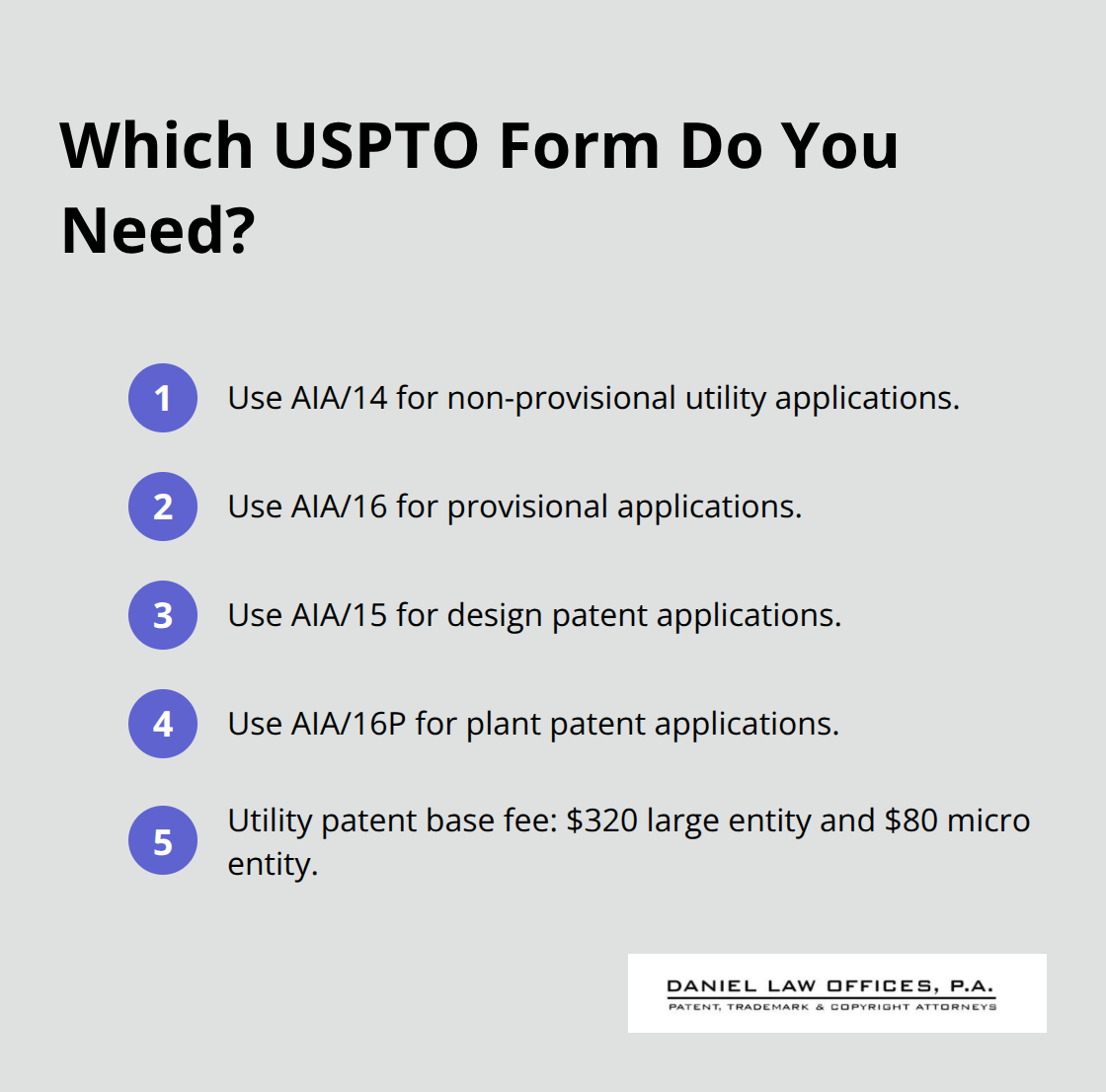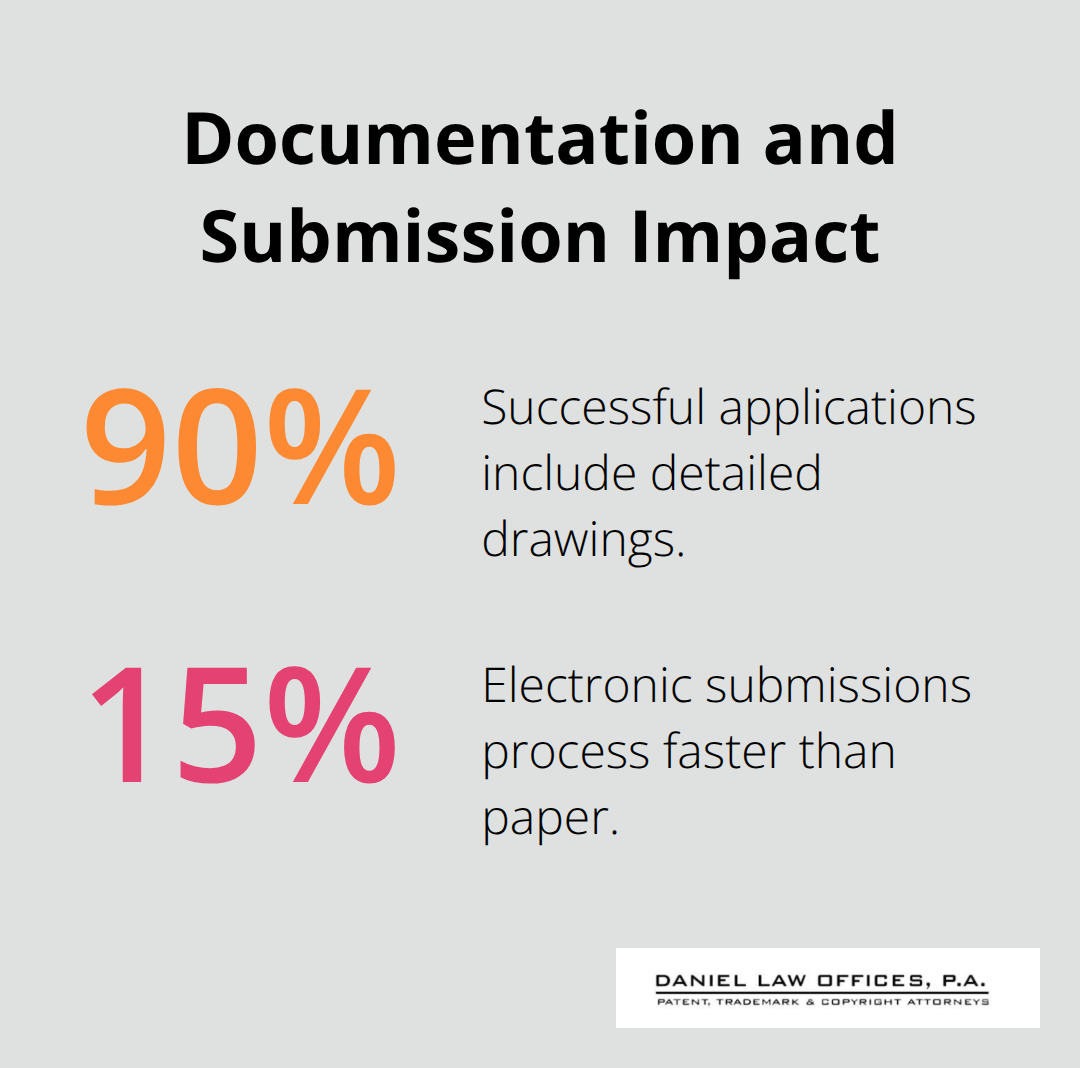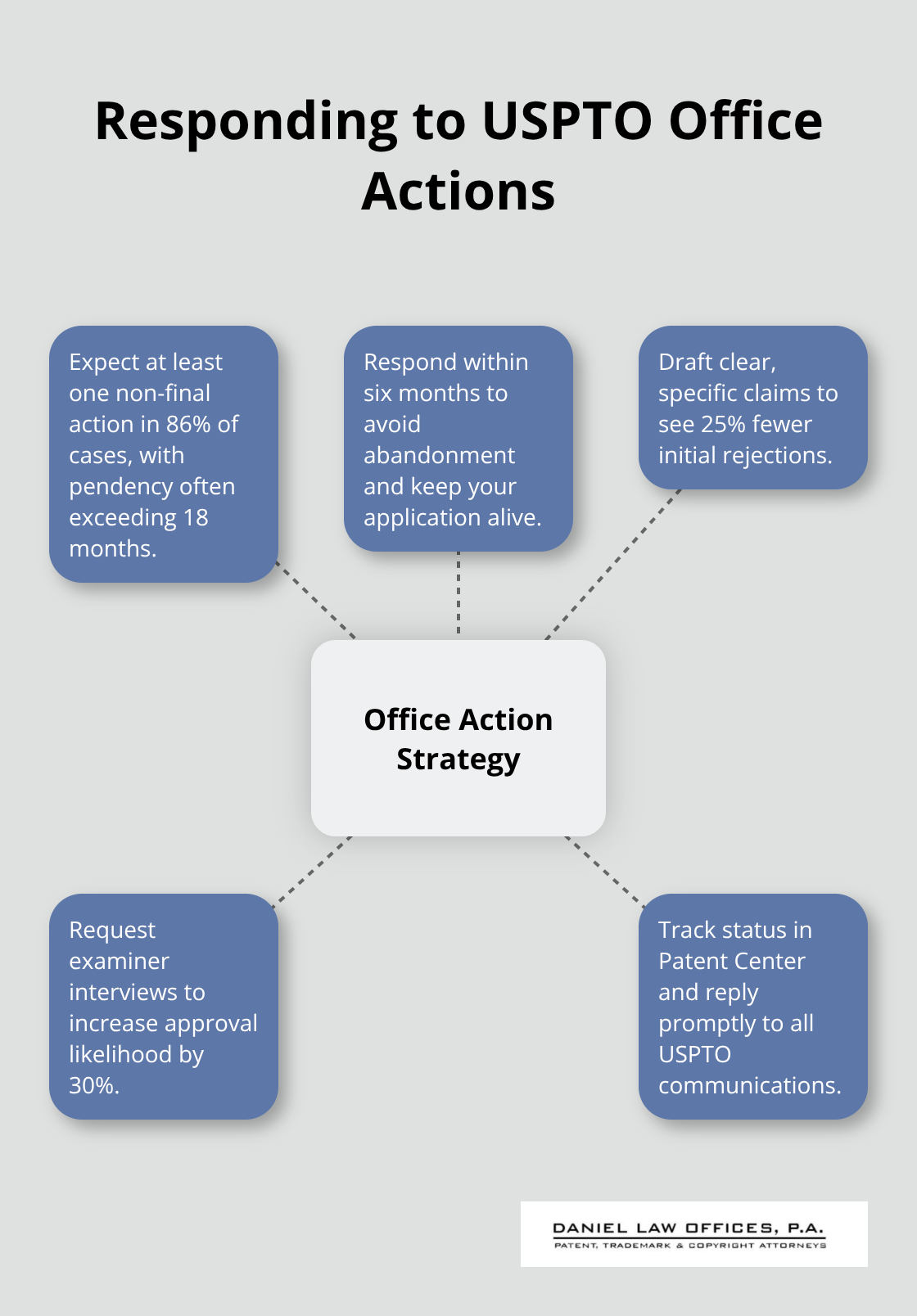Patent Filing Form A Complete Guide for Orlando, Florida
Filing a patent application requires navigating complex USPTO requirements and submitting the correct patent filing form for your invention type. The process involves multiple steps, strict deadlines, and significant costs that can impact your intellectual property strategy.
We at Daniel Law Offices, P.A. have guided countless inventors through this process. Understanding the requirements upfront saves time and prevents costly mistakes that could delay or derail your patent application.
Which Patent Forms Do You Actually Need
The USPTO requires different forms based on your patent type, and incorrect choices cost time and money. Utility patents demand Form AIA/14 for non-provisional applications, while provisional applications use the simpler AIA/16 cover sheet. Design patents require Form AIA/15, and plant patents use Form AIA/16P. Each form triggers different fee structures, with utility patents costing $320 for large entities versus $80 for micro entities according to current USPTO fee schedules.

Required Documentation Beyond Basic Forms
Your application package must include the Application Data Sheet, specification document, claims section, and drawings when necessary. The USPTO reports that 90% of successful applications include detailed drawings, while applications that lack proper documentation face automatic rejection. Patent drawings must meet strict requirements including specific margins, line weights, and labels. Electronic submission through USPTO Patent Center reduces processing time by 15% compared to paper submissions, though paper applications add a $400 penalty fee.

The specification document averages 10,000 words for utility patents and must describe your invention thoroughly enough for someone skilled in the field to recreate it.
Critical Errors That Kill Applications
Incomplete applications represent the biggest mistake inventors make, with approximately 60% of first-time applicants receiving non-final rejections due to preventable errors (according to USPTO data). Missing inventor declarations, incorrect entity status claims, and inadequate prior art disclosure trigger immediate rejections. Format violations including improper claim numbers, missing reference numerals in drawings, and incorrect specification structure cause delays that average six months. Patent applications involve dozens of forms, drawings, and supporting documents that must stay synchronized throughout the filing process. Applications prepared with professional legal assistance show 10% higher approval rates and 25% fewer initial rejections compared to self-filed applications.
Electronic vs Paper Submission Requirements
The USPTO strongly encourages electronic submissions through their Patent Center platform. Electronic applications process 15% faster and allow real-time document compatibility checks. Paper applications face additional scrutiny and must convert all documents to PDF format before submission. The $400 paper penalty fee makes electronic submission the clear choice for most inventors (especially those watching their budget closely).
The next step involves conducting thorough prior art searches to establish your invention’s novelty before you submit any forms.
How Do You Navigate the Patent Filing Steps
Prior art searches form the foundation of successful patent applications, yet 8% of applications fail due to lack of novelty according to USPTO data. The Orange County Library System in Orlando provides free access to USPTO databases and trained staff who assisted over 500 local inventors in 2022. Professional search services cost between $500-2000 but uncover hidden prior art that basic searches miss.
Search the USPTO Patent Full-Text Database, Google Patents, and international databases including WIPO Global Brand Database. Document every reference you find with publication dates, patent numbers, and relevance notes. This documentation becomes critical when you draft your application and respond to office actions.
Application Package Preparation
Your specification document must describe the invention thoroughly enough for someone skilled in the field to recreate it (utility patents average 10,000 words). Applications with detailed specifications show 30% higher approval rates without major modifications according to USPTO statistics. Include background information, detailed description of preferred embodiments, and at least one working example.
Patent drawings appear in 90% of successful applications and must meet strict USPTO formatting requirements including specific margins and line weights. High-quality drawings increase approval rates by 20% without additional office actions. Electronic submission through USPTO Patent Center processes 15% faster than paper applications and provides real-time compatibility checks.
File your Application Data Sheet, specification, claims, and drawings simultaneously to avoid processing delays that average six months for incomplete packages.
USPTO Review Response Management
Approximately 86% of patent applications receive at least one non-final Office Action during examination, with the typical pendency period exceeding 18 months. Office Actions must receive responses within six months or your application becomes abandoned. Applications with clear, specific claims face 25% fewer initial rejections compared to vague applications.

Address every examiner concern thoroughly in your response, providing technical arguments and claim amendments when necessary. Interview requests with patent examiners increase approval likelihood by 30% through direct negotiation. Track your application status through USPTO Patent Center and respond promptly to all communications.
Applications prepared with attorney help show 10% higher approval rates overall, which makes professional guidance valuable during this complex patent filing process. Understanding the patent filing requirements helps inventors budget appropriately for the complete patent process.
What Does Patent Filing Actually Cost
Patent filing costs vary dramatically based on your entity status and application type. Large entities pay $320 for basic utility patent fees, while small entities pay $160 and micro entities pay just $80 according to current USPTO fee schedules. These base fees represent only the start, as search fees add another $700 for large entities, $350 for small entities, and $175 for micro entities. Examination fees tack on an additional $800, $400, or $200 respectively.
Hidden Costs Add Up Fast
Most inventors underestimate total costs because they focus only on basic fees while they ignore search, examination, and maintenance fees that can reach $12,000 over a patent’s 20-year life. Multiple dependent claims trigger additional fees beyond standard costs. Issue fees require payment before the USPTO grants your patent (ranging from $500 to $1,200 based on entity status). Maintenance fees come due at 3.5, 7.5, and 11.5 years after patent grant, with costs that escalate from $400 to $7,700 for large entities.
Timeline Expectations by Patent Type
Utility patents take 18-24 months for initial examination, with the entire process that stretches 2-4 years based on complexity and USPTO workload. Design patents process faster at 12-18 months due to simpler examination requirements, while plant patents follow similar timelines to utility applications. Provisional applications receive no examination but provide 12 months of patent pending status before they require conversion to non-provisional applications. The USPTO processed over 650,000 applications in 2020, which created backlogs that extend processing times significantly.
Professional Legal Fees Dominate Budgets
Professional patent attorney fees typically range from $8,000 to $15,000 for complete utility patent applications, which dwarf USPTO fees for most inventors. Simple mechanical inventions cost less while complex software or biotechnology patents command premium rates. Attorney-prepared applications show 10% higher approval rates and face 25% fewer rejections according to USPTO data. Self-filed applications save money initially but often require expensive corrections that exceed attorney fees. Budget $12,000 to $20,000 for professional utility patent work that includes all USPTO fees, attorney time, and potential office action responses.
Final Thoughts
Patent filing success requires thorough preparation, accurate documentation, and strategic timing. The USPTO data shows that applications with detailed specifications achieve 30% higher approval rates, while attorney-prepared submissions face 25% fewer rejections. These statistics highlight the importance of getting your patent filing form and supporting documents right from the start.
Professional legal assistance becomes necessary when your invention involves complex technology, when you face office actions that require technical responses, or when your budget allows for the $12,000-$20,000 investment that typically yields better outcomes. Self-filing works for simple mechanical inventions, but software, biotechnology, and multi-component systems benefit from professional guidance. After you file your application, monitor USPTO communications through Patent Center and respond to office actions within six months to avoid abandonment.
We at Daniel Law Offices, P.A. guide inventors through comprehensive patent searches, application drafting, and USPTO prosecution processes (our registered patent attorney helps clients navigate intellectual property complexities while protecting their innovations). The examination process averages 18-24 months, during which you can use “Patent Pending” status for marketing advantages. Contact Daniel Law Offices, P.A. to discuss your patent filing strategy and protect your valuable ideas through proper legal channels.

